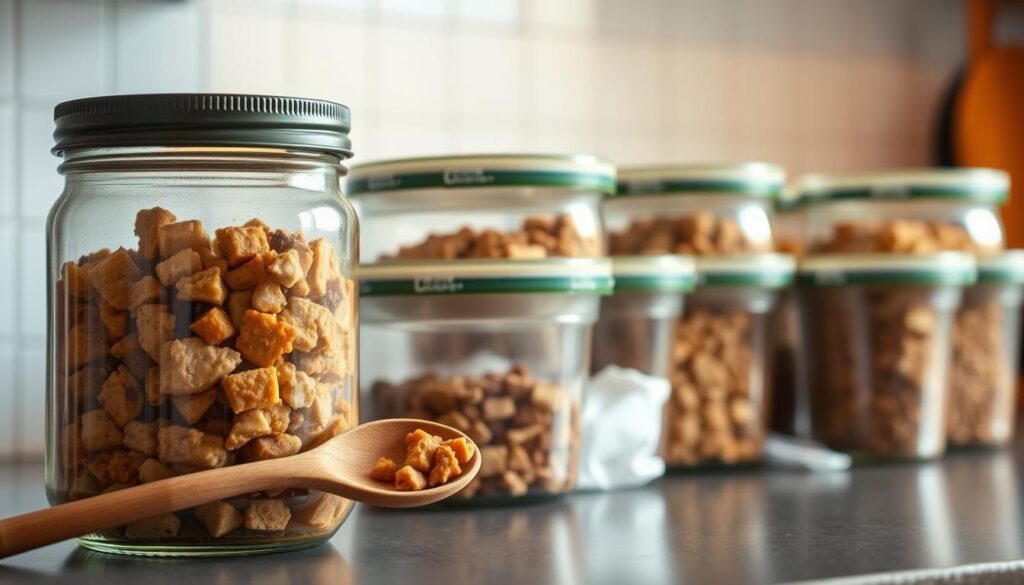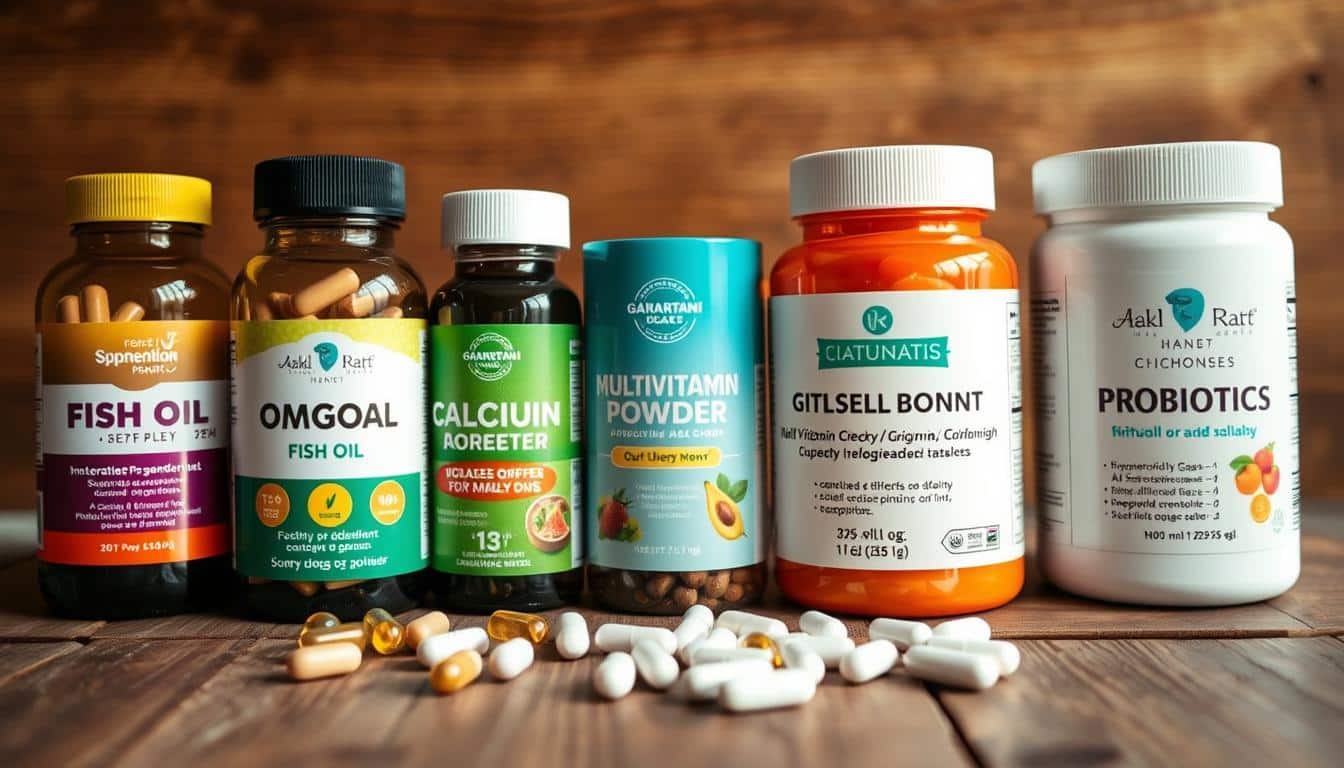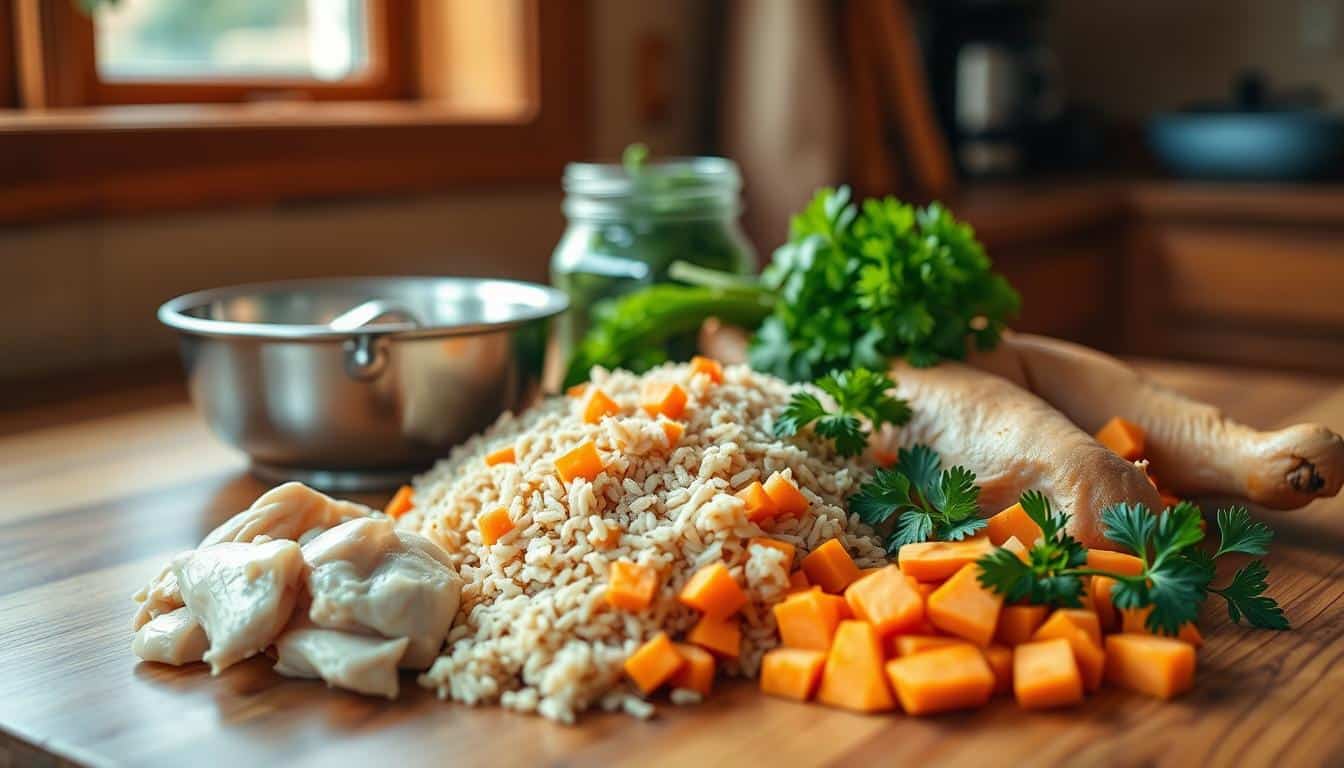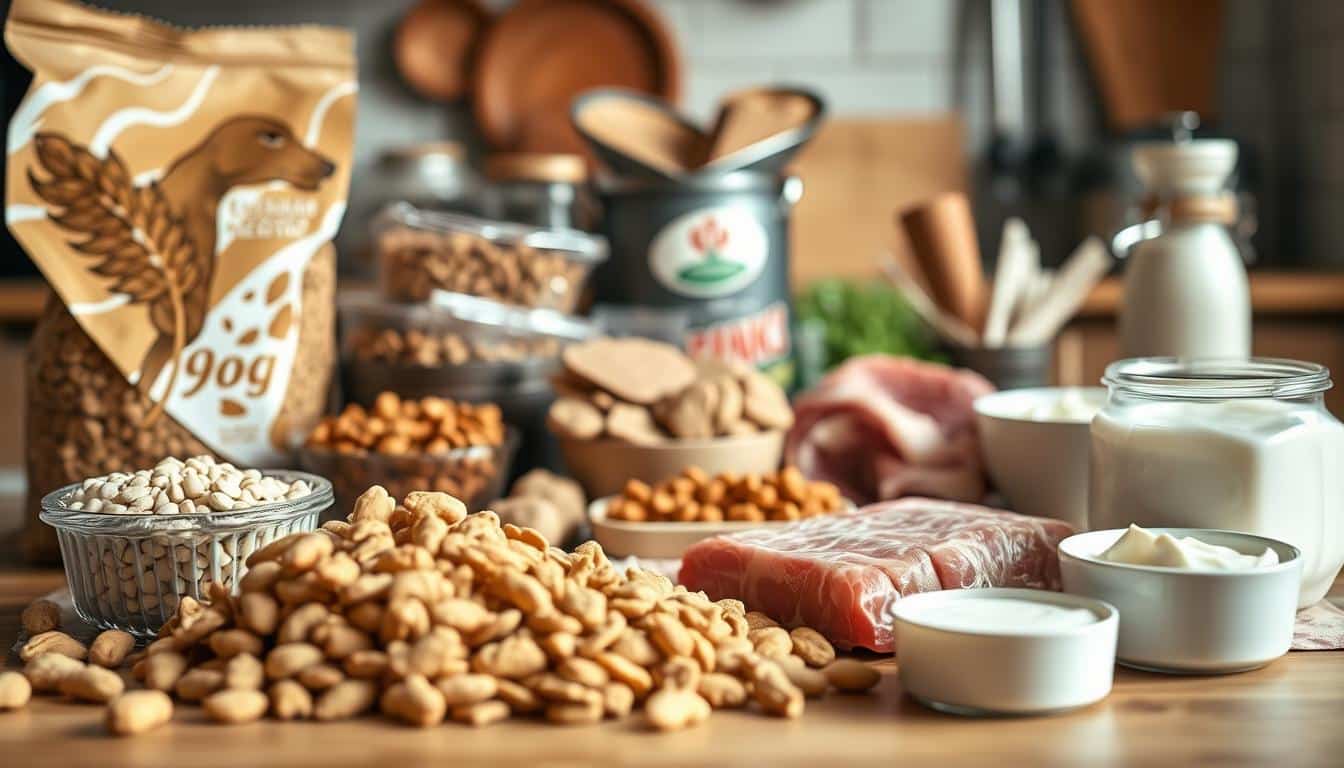This recipe is perfect for dogs with sensitive stomachs. It’s vet-approved and focuses on soothing upset tummies. Made with lean turkey and plain pumpkin, it’s low in fat. It provides proteins and fibers that are easy to digest.
Here, you’ll find everything you need to know. We cover safe ingredients, how to cook low-fat meals, and serving sizes. We also talk about how long you can keep the food in the fridge or freezer. This advice comes from experts like The Canine Dietitian and protocols for dog pancreatitis.
This is a great starting point if you’re making homemade food for a dog with a sensitive stomach. The upcoming recipe aims to ease digestive issues. It also offers steps to help your pet return to regular meals under a vet’s care.
Why Turkey and Pumpkin Are Ideal for Sensitive Stomachs
Dogs with sensitive stomachs may find relief with a simple diet. Lean turkey and pumpkin can make recovery easier while providing necessary nutrition. This combination offers digestible protein and natural fiber, helping maintain stool consistency and reduce irritation.
Ground turkey breast is a great choice for dogs needing low-fat diets. Opting for 99% fat-free turkey delivers key nutrients without the extra fat. These include amino acids and B vitamins, which are essential for tissue repair and a strong immune system. Lean turkey is especially good for dogs sensitive to other meats or those with pancreatitis.
Pumpkin contributes by adding soluble fiber, which helps with both loose and hard stools. Using plain canned pumpkin or homemade puree can support your dog’s digestive health. It acts as a mild prebiotic and supports the growth of healthy gut bacteria. Plus, it’s a low-calorie way to add moisture to your dog’s diet.
Turkey and pumpkin together support your dog’s recovery from stomach issues. Pumpkin provides nutrients like beta-carotene and vitamin C which help fight inflammation. Turkey offers vitamins important for energy metabolism. This combination is often recommended for dogs needing a diet that’s both anti-inflammatory and easy to digest.
- Low-fat protein: supports muscle repair without added digestive stress.
- Soluble fiber: regulates bowel movements and soothes the gut.
- Antioxidants and minerals: assist recovery and moderate inflammation.
Understanding Sensitive Digestion and Pancreatitis in Dogs
Many caregivers see changes when a pet has a sensitive stomach. Clear signals help choose meals for them. They also tell you about more serious issues. Watch your dog’s eating, pooping, and energy before changing its food.
Common signs of digestive sensitivity
Vomiting, diarrhea, or soft poops after eating are signs. A dog might seem in pain and not want to eat. You might see less energy and a coat that’s not shiny.
Watch how your dog reacts to new foods. Good signs are eating well, normal poops, and more energy.
Why low-fat, easily digestible meals matter
Too much fat can upset the pancreas. A low-fat diet helps avoid pancreas problems. Use lean turkey and pumpkin for less fat.
Choose easy-to-digest foods like white rice. Therapeutic recipes keep fat really low. They aim for about 1–2 grams of fat in each meal.
When to seek veterinary guidance
Call your vet right away for bad vomiting, diarrhea, belly pain, or if your dog is very tired. If your dog won’t eat for over 24 hours, get help fast.
- Persistent symptoms despite bland food
- Signs of a bigger illness like fever
- Long-term homemade meals beyond a few weeks
For long-term meal plans, talk to your vet. They can help make sure your dog gets everything it needs. Working with a vet can help your dog stay healthy and avoid more problems.
Turkey and pumpkin recipe for sensitive dogs
This recipe is great for dogs with tummy troubles or who are getting better from pancreatitis. It’s made to be a low-fat, easy-to-digest meal. Use it once for recovery or as part of a rotation with your vet’s advice. Remember, no seasonings, onions, or garlic. And definitely, no pumpkin pie mix.
Recipe overview and goals
Our main goal is to offer gentle calories and lean protein. Plus, we add soluble fiber to help your dog’s gut feel better. Start with 1 lb of lean ground turkey breast. Look for 99% fat-free if you can. Also, grab some plain canned pumpkin puree, and cooked rice. Maybe toss in soft-cooked carrots or green beans for extra texture and vitamins. If it’s okay with your vet, add a teaspoon of olive or flaxseed oil after cooking. These oils give essential fatty acids.
Therapeutic nutrient profile (low fat, moderate protein, fiber)
We aim to make each cup of this therapeutic dog meal about 150–175 kcal. It should have 11–16 g of protein and 1.6–2.3 g of fat to keep it really low in fat. Expect 10–22 g of carbs and 2–3 g of fiber per cup. This will help with your dog’s stool quality. If dealing with pancreatitis, always listen to your vet and keep fat below 10–12% of what your dog eats in calories.
Sometimes, recipes need a bit of calcium to get to a safe calcium-to-phosphorus ratio. You might add something like 0.25 tsp of calcium carbonate per batch. But, always talk to your vet before feeding this to your dog long-term or adding any supplements.
Portion and serving guidelines by weight and condition
This table is a good place to start for portion sizes. But remember to change it based on how active your dog is, their health, and advice from your vet.
- Small dogs <20 lbs: 1/3–1/2 cup per meal
- Medium dogs 20–50 lbs: 1/2–1 cup per meal
- Large dogs 50–90 lbs: 1–1.5 cups per meal
- Giant breeds >90 lbs: 1.5–2 cups per meal
If your dog is in the middle of recovery, break their food into 4–6 small meals a day. For regular times, 2–3 meals a day works well. Always keep an eye on their weight every week. And check in with your vet to make sure you’re giving them the right amount. This is super important for dogs with special health needs like pancreatitis.
Ingredients and safe substitutions for sensitive pups
When picking safe ingredients for sensitive dogs, start with simple, whole foods. These help calm the stomach and ease the pancreas. Below, we list lean protein, soluble fiber, gentle carbs, and plain veggies you can trust. Remember to place the image to highlight the pumpkin element.
Recommended core ingredients and why each is used
- Ground turkey breast (99% fat-free): a lean protein that’s easy to digest and eases pancreatic pressure.
- Pumpkin puree dog (plain canned or cooked fresh): packed with soluble fiber, it aids in hydration and regular bowel movement.
- Rice (white or brown): a soft carb. White rice is gentler for upset stomachs, while brown rice boosts fiber if tolerated.
- Carrots and green beans: low-fat veggies full of vitamins and texture; cook and blend or finely chop for delicate pups.
- Water or low‑sodium chicken or turkey broth (no onion/garlic): for cooking grains and safely adding moisture.
- Optional, with vet okay: a touch of olive or flaxseed oil post-cooking for omega‑3s, and measured calcium for ongoing feeding.
Vet-safe substitutions: white rice, quinoa, sweet potato
- White rice: A top pick for dogs with serious GI issues or those needing bland food; it’s smooth to digest and soothing.
- Quinoa: Rich in protein and fiber. Introduce it slowly and mind the dog’s tolerance.
- Sweet potato: A great choice if your dog isn’t into pumpkin; similar in fiber. Make sure to cook and mash it well.
- Oats: Yet another mild carb alternative for changing things up or if grains are an issue.
Ingredients to avoid and why
- Seasonings and added salt: These can upset the dog’s stomach and hide bad quality food.
- Onion, garlic, chives: Allium family members, toxic to dogs, definitely a no-go.
- Pumpkin pie filling or spiced pumpkins: They contain harmful sugars, nutmeg, or spices.
- High‑fat meats, processed meats, and fried foods: Elevate pancreatitis and digestive trouble risk.
- Human sauces, gravies, and anything with xylitol or artificial sweeteners: Risk acute toxicity or digestive issues.
When thinking about swapping dog food ingredients, change just one at a time. Watch their stool, energy, and how hungry they are. Write down the changes and any reactions. Open talk with your vet makes sure any changes are good for your dog’s health, based on their age, weight, and medical background.
Step-by-step preparation methods
Making a simple meal for a sensitive dog is easy with clear steps. Here are two methods to keep texture, fat, and nutrients in check. Always follow your vet’s advice for any major changes and supplements.
One-pot gentle simmer method for extra-tender results
The turkey pumpkin one-pot meal is soft and easy on the stomach. Take lean turkey, raw rice, pumpkin puree, and water. Put them all in a big pot.
- Mix 1 lb lean turkey, 1 cup raw rice, 3/4–1 cup pumpkin, and 3 cups water.
- Heat until it boils softly, then simmer on low heat for 30–35 minutes until the rice is soft.
- Add chopped spinach at the end so it wilts; let it cool before you serve it.
- If your vet thinks it’s okay, add 1 tbsp of flaxseed oil or olive oil once it’s cool for extra fat.
Keep it in the fridge for up to 3 days or freeze it for 2 months. This method is great for dogs getting over a stomach upset.
Skillet-and-rice method for texture control
If you want to control the meal’s texture or feed pureed veggies, try this. It lets you adjust the food’s hardness and wetness by cooking things separately.
- Cook rice as the package says and put it to the side.
- Cook turkey in a non-stick pan without oil until browned. Make sure to break it into small bits and get rid of any fat.
- Soften veggies like carrots and beans, then mash or puree them for dogs with a delicate stomach.
- Then mix the turkey, rice, veggies, and pumpkin puree while everything’s still warm.
- Add calcium carbonate if your vet says it’s okay and some oil or ground flaxseed once it’s cooled down.
This method lets you adjust the food’s texture and moisture for your dog’s needs.
Finishing touches and adding omega-3s safely
Be careful when finishing up the meal. Add oils only when the food’s cool and if your doctor says it’s okay for dogs with pancreatitis. Using small amounts lessens risks and keeps health benefits.
- Only put a little flaxseed oil or vet-recommended fish oil in the food after it cools, and mix well.
- Don’t add oils while cooking to keep the fat down and maintain a mild food profile.
- For long-term feeding, ask your vet about the right omega-3 oil dose and brand for your dog.
Following these steps makes a reliable turkey pumpkin meal routine. It aids recovery and simplifies homemade dog food.
Storage, reheating, and shelf life
Storing meals properly keeps your dog healthy and safe. When storing homemade dog food, plan the portions. This keeps the food fresh and nutrient-rich. Labeling and proper thawing make meal prep for dogs easier and safer.

Refrigeration timelines and freezer portioning
Store cooked turkey and pumpkin in airtight containers in the fridge. They can stay there for 3–4 days. If you need to store meals longer, freeze them in single-meal portions. This reduces waste and makes thawing quicker.
The best quality in the freezer is for about 2–3 months. Always thaw overnight in the fridge before you reheat. This keeps the food safe and tasty.
Safe reheating practices and serving temperature
When reheating food, make sure it’s warm, not hot. Lukewarm food avoids burns and keeps the nutrients. Stir the food well if you’re using a microwave to avoid hot spots.
Reheat food gently on the stove or in short bursts in the microwave. Always check the temperature before serving to your dog. Never refreeze food that’s been thawed. Throw away any food left out for more than two hours.
Labeling and rotation tips for meal prep
Always date and label each container with what’s inside and the date it was made. Rotate your containers, using the oldest ones first. This keeps everything fresh in your fridge and freezer.
- Rotate low‑fat recipes alongside veterinarian‑recommended complete diets for balance.
- For dogs with health issues, keep a simple feeding log to watch for any reactions.
- Plan your cooking so you match your dog’s meal sizes and avoid wasting food.
Transitioning your dog to this homemade diet
Switching your dog to a new homemade food must be done slowly and with care. This approach aids digestion and helps pets that are recovering from health issues. Here are detailed plans and tips for managing the change and keeping track of your pet’s health.
- From another homemade diet: Day 1–2: 75% current diet / 25% new. Day 3–4: 50/50. Day 5–6: 25/75. Day 7: 100% new.
- From commercial food: Day 1–3: 75% commercial / 25% new. Day 4–6: 50/50. Day 7–9: 25/75. Day 10: 100% new.
- For very sensitive dogs or pancreatitis: extend the timeline to 2–3 weeks and slow the increments. Consult your veterinarian for individualized advice.
How to monitor tolerance and adjust the pace
Track daily feeding, stool consistency, energy levels, appetite, and any vomiting. This helps see how well your dog is adjusting. If you notice a slight change in stool firmness, slow down the switch. Stick with the current food ratio for a little longer.
If your dog starts vomiting, experiencing severe diarrhea, showing signs of pain, or acting very tired, stop the new food and talk to your vet immediately. Keeping accurate records helps your vet provide the best advice.
Signs of improvement and warning signs to stop
- Good signs include firmer stools, eager eating, more energy, fewer vomit episodes, and a glossier coat.
- Seek medical attention if your dog vomits often, has ongoing watery stools, won’t eat, shows signs of abdominal pain, or if their condition worsens.
Follow the suggested schedule for changing foods, but always watch your dog’s reaction closely. By carefully observing and jotting down notes, you can ensure a safe and smooth transition for your dog, especially if they’re sensitive.
Nutrition considerations and when the recipe is not complete
This turkey and pumpkin meal aids in short-term recovery. But, it doesn’t have all vitamins and minerals for long-term health. Such homemade recipes should be temporary unless you consult a vet.
Why homemade meals may need supplementation long term
Home-cooked food can help heal the gut for one to two weeks. But feeding it long-term can miss essential nutrients like calcium, phosphorus, and vitamins. Puppies, pregnant dogs, and older pets need more specific nutrition.
Common supplements vets recommend for extended feeding
- Multivitamin/mineral premixes formulated for dogs to fill gaps in nutrition.
- Calcium sources like calcium carbonate or bone meal for balance.
- Omega-3 fatty acids from fish oil for health and coat.
- Probiotics to support digestion and gut health.
- Digestive enzymes for specific health conditions.
Always get a vet’s advice before adding supplements. Too much can be harmful. Even one wrong dose can upset a dog’s nutritional balance and cause health issues.
Balancing calories, calcium/phosphorus, and micronutrients
Keep an eye on calorie intake to keep your dog’s weight healthy. Therapeutic homemade recipes are about 150 to 175 kcal per cup. Adjust the amount to fit your dog’s size and energy needs.
For regular feeding, aim for a calcium-to-phosphorus ratio of about 1:1 to 1.5:1. Always work with a vet or a nutrition expert for long-term planning. They help with vitamins, check calcium needs, and make a safe supplement plan.
Recipe variations and serving ideas for picky or recovering dogs
Homemade meals can be adapted to be gentler for dogs with stomach issues or recovering from pancreatitis. By following the tips shared, you can create low-fat dog food. These versions preserve the nutrients while ensuring digestion is smooth.
To aid in the pancreas’ healing, opt for much lower fat options. Select 99% fat-free ground turkey breast or lean cooked turkey. Cooking should be done without extra oil in a skillet that doesn’t stick, and any fat that appears should be removed.
- Choose white rice over brown to reduce fiber and make stools easier to pass.
- Cut back on oils and fats, but if omega-3s are necessary, only use a tiny amount.
- Stay away from skin and dark meat as they have more fat.
For dogs finding it hard to chew or digest food quickly, how the food feels can make a big difference. Try making vegetables into a puree and mashing rice for a soft, even meal.
- Make dog food easier to digest by pureeing veggies like pumpkin, carrot, or squash with turkey and rice.
- Serving the food a bit warm can make it smell better and more appealing.
- For dogs who are fussy eaters, consider adding a bit of plain, low-fat yogurt, but only if your vet agrees.
Add toppers to make the meals tastier and to keep your dog interested, but make sure they’re healthy. These extra bits should be small and not mess up the meal’s nutrition.
- Try adding cooked white fish, cooked egg whites, or a little low-fat cottage cheese as toppers.
- Toppers should be less than 10% of the daily calorie intake, unless your vet says otherwise.
- Add new toppers slowly and watch for any bad reactions.
Be careful when changing proteins to avoid upsetting your dog’s stomach. When introducing new proteins, do it gradually over 7 to 10 days. Always watch how your dog’s body reacts, especially their stool and how eager they are to eat.
- Start by replacing only 10% of the current protein with a new one on the first day.
- Then, if your dog is okay with the switch, increase the new protein by 10% every few days.
- If your dog starts to feel unwell, stop immediately and talk to your vet before trying again.
It’s smart to keep track of what your dog eats, which toppers they like, and how they react. Keeping detailed notes will help you and your vet come up with the best low-fat food choices. These choices will aid in recovery and comfort over time.
Conclusion
This turkey and pumpkin dog meal is a great choice for dogs with sensitive stomachs. It combines lean turkey breast, plain pumpkin puree, and white rice. This mix is low in fat, easy to digest, and packed with protein, fiber, water, and antioxidants.
Here’s a quick guide: use 99% fat-free ground turkey to protect your pup from pancreatitis. Also, make sure not to use pumpkin pie filling and add oils only if the vet says it’s okay. You can keep these meals in the fridge for 3 to 4 days. Or freeze them for up to 3 months. When switching foods, do it slowly and watch how your dog reacts.
Thinking about feeding this to your dog for a while? Talk to your vet or a pet nutrition expert first. They can advise you on adding supplements and keeping the diet balanced in calcium, vitamins, and minerals. With the right care, a turkey-and-pumpkin diet can help calm your dog’s sensitive tummy and aid in their recovery.
FAQ
What are the safest ingredients in the turkey and pumpkin recipe for a dog with sensitive digestion or pancreatitis?
Why choose ground turkey breast over regular ground turkey?
How does pumpkin help my dog’s digestion?
What portion sizes should I feed by dog weight and condition?
How should I cook the recipe for the gentlest digestion?
Can I add oils or supplements for omega‑3s?
How long can I refrigerate or freeze homemade turkey and pumpkin meals?
What is the safest way to reheat and serve the food?
How quickly should I transition my dog from their current diet to this homemade recipe?
What signs indicate my dog is tolerating the new food or that I should stop?
Will this recipe meet all my dog’s nutritional needs long term?
What common supplements might my vet recommend when feeding this diet longer term?
What ingredients must I avoid completely?
How can I adjust the texture for dogs that struggle to chew or digest?
Are there safe substitutions if my dog dislikes pumpkin or rice?
How should I label and rotate batches when meal‑prepping?
When should I contact my veterinarian about this diet or my dog’s recovery?
Content created with the help of Artificial Intelligence.



